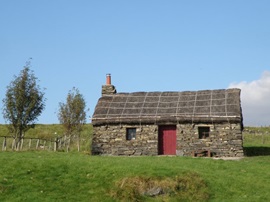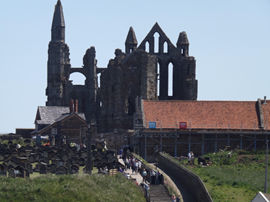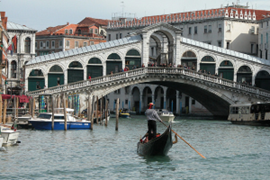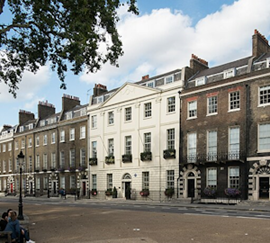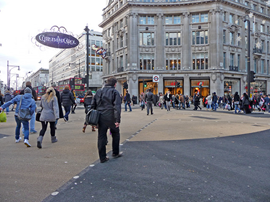The history of Boston
The influence of its river is seen in Boston’s grand medieval and Georgian architecture, built on trade and agriculture, and in the engineering works that still protect the town.

|
| Georgian warehouses on the River Witham. |
If you think of Boston, the chances are your thoughts will go to Boston, Massachusetts, and if you think of Boston and water, most likely the Boston Tea Party. However, the original Boston, the one in Lincolnshire and nestled on the east coast of the edge of the Fens and the Wash, is a town that arose due its position on an important tidal river. Boston thrived for centuries on its ability to access national and international trade.
The Witham is a river almost entirely in the county of Lincolnshire in the east of England. At Boston the Witham flows into the Haven, a tidal arm of the Wash. The archaeological record tells us the Witham has a transport history dating from Roman times. This trading history became well established at Boston, a seaport for over 800 years, due the town’s ability quickly and easily to access the trading routes of the North Sea. Severe flooding in 1014 moved the mouth of the river, enabling Boston to become an important port.
One of the best-known, and widely shared facts about Boston, is that in the middle ages it was second only to London as the most active port in England (ask any local and they will tell you). Despite not being mentioned in the Domesday Book (although the parish of Skirbeck, now a suburb of Boston, was), by the 1280s a third of England’s wool exports went out of Boston. It was a thriving international port, exporting wool from monastic estates and salt from the Lincolnshire coast, among other high-value goods, and importing wine, furs, leather and spices. The town’s wealth and importance can also be demonstrated through its 14 guilds, four friaries and a hospital. As international trade flourished, Boston became an active and significant part of the Hanseatic League, a trading organisation that dominated the trade of the North Sea and the Baltic. The wealth that flowed into the town in this period is exemplified by the magnificent St Botolph’s Church and the 14th-century Guildhall.
The increase in English cloth production meant that less wool was exported, and Boston saw a post-medieval decline in trade; and the gradual silting up of the River Witham meant that fewer large vessels were able to reach the centre of town. A significant investment in infrastructure was undertaken with the creation in 1569 of the Maud Foster Drain, a substantial north-south drain created to prevent excess water from entering the town.
Despite efforts to save Boston’s trade, the international trade and Hanseatic involvement in the town reduced from the early 16th century. Boston traded goods on a regional level, with limited international exports. Potentially the town’s most famous (attempted) export was in 1607, when the Haven, between Boston and the sea, was the scene of the first, unsuccessful, attempt of the Scrooby Pilgrims to leave England. Ultimately, in 1620, they became part of the original settlement of Plymouth, Massachusetts.
The post-medieval decline of Boston was to dramatically reverse in the Georgian period. Like much of the east of England, the area around Boston was drained and enclosed in the 18th century. The improvements in agriculture led to a renaissance of Boston as a prosperous town, but it was the dramatic Georgian waterway engineering that had the most lasting impact. The Witham at the northern end of town was originally a winding river that opened out into a wide pool. The route of the old river can almost be seen on Wormgate, one of Boston oldest streets, which followed the route of the river it ran adjacent to. The winding medieval street today is at significant odds with the ruler-straight river it sits alongside.
The creation of the Maud Foster Drain, and the North and South Forty Foot Drains (c1720 and c1760 respectively) reduced the flow of water into the town so much that the Witham began to silt up at an increasing rate. The silting affected trade, so the decision was made to canalise the Witham north of the town centre. The Grand Sluice, completed in 1766, was a major construction which maintained the height of water above Boston to near normal high-tide level. This improved local trade and re-established international trade, making Boston once again a wealthy port town. Another innovative Georgian engineering work, the Black Sluice, helped to separate the tidal Haven from the inland waterways.
These extremely costly and time-consuming engineering works exemplify the investment into Boston at this time. This was further reinforced by the rebuilding of the western side of the medieval marketplace, including large-scale civic architecture such as the Exchange Buildings (1772) and the Assembly Rooms (1822). This was also the period in which Boston expanded beyond its medieval boundaries. The Bar-ditch, an 11th or 12th century ditch surrounding the eastern side of the town, was filled in and eventually lost. The Georgian wharf buildings to the south of the town centre, one of the most complete collections of this type of structure in the country, are of national significance.
The Victorian period again saw a distinct change in the way in which Boston interacted with its waterways. This time the movement was away from the town centre and the traffic became more focused on the coast. Boston was the largest and richest town in the county in the mid-19th century, but the introduction of the railway, with the opening of the Great Northern Railway East Lincolnshire line in 1848, impacted on the prosperity of the trade in the centre of town. Boston once again became a significant port in trade and fishing in 1884, when the new dock with its associated wharves on the Haven were constructed by Boston Corporation. It continues today as a working port, exporting grain and fertiliser, and importing timber, although much of the fishing trade was moved out between the wars.
From the town itself, the Witham is still navigable from Brayford Wharf in Lincoln to Boston. Commercial traffic, apart from tour boats, has ceased above the port of Boston, and only pleasure craft carry on through the lock at the Grand Sluice into the Witham. In the 20th century Boston port expanded significantly. Today it covers 246 square kilometres of the Wash, providing vital infrastructure for the region, importing and exporting a variety of materials, including steel and grain.
In December 2013 a tidal surge caused the Haven to burst its banks in Boston, devastating homes and businesses. More than 50 streets were hit, and around 800 homes flooded. Since then, the £100 million Boston Barrier has been constructed, becoming fully operational in 2020. This barrier gate, which can be raised in just 20 minutes, is said to provide flood protection to more than 13,000 homes and businesses.
Boston thrived because of its ability to use its navigable waterways and position itself as an important and significant port for Lincolnshire, England and Europe. When the use of the tidal rivers changed and developed over the centuries, the town adapted to maintain its significance as a centre for trade. The river is still a dominant feature. Its legacy is seen in the winding nature of Wormgate, the grand medieval and Georgian architecture built on trade and agriculture, and the innovative engineering works that still protect the town today. The history of the river and its access to the coast is still a sense of pride because, in case you did not already know, Boston in the middle ages was second only to London as the country’s most important port.
This article originally appeared as ‘Boston, a town with water at its heart’ in the Institute of Historic Building Conservation’s (IHBC’s) Context 175, published in March 2023. It was written by Matt Bentley, senior manager at Heritage Lincolnshire, a county-based building preservation trust and consultancy, and chair of the East Midlands branch of the IHBC. Heritage Lincolnshire provides a consultant conservation officer service to Boston Borough Council, and is delivering over £6 million in regeneration projects to the town.
--Institute of Historic Building Conservation
Related articles on Designing Buildings
- Boston Council Section 215 prosecution for failure to maintain listed building.
- Conservation area.
- Conservation.
- Conserving Great Yarmouth's cultural heritage.
- Heritage.
- Historic environment.
- IHBC articles.
- Institute of Historic Building Conservation.
- Listed buildings.
- Lowestoft's heritage action zones.
- The Red House in Aldeburgh.
IHBC NewsBlog
IHBC Publishes C182 focused on Heating and Ventilation
The latest issue of Context explores sustainable heating for listed buildings and more.
Notre-Dame Cathedral of Paris reopening: 7-8 December
The reopening is in time for Christmas 2025.
Stirling Prize-winning Salford building to be demolished
The Centenary Building will be bulldozed as part of the wider £2.5bn Crescent regeneration project
Volunteers work to transform 100-year-old ‘hidden’ building into bothy
The building, named Druimnashallag, is located southeast of Oban.
The new ‘Arches for HERs’ Demo site, from the Getty Conservation Institute via HE
It shows how organisations responsible for historic environment records (HER) management can benefit from its powerful features.
ICOMOS-CIF 2024 Symposium celebrates 40th anniversary in Venice
It aims to critically review current practices and theories of conservation of built heritage around the world, and more.
HES establishes new national centre for retrofit of traditional buildings
HES plans to develop the centre follows £1m of funding from UKRI Arts and Humanities Research Council.
High Court rejects oral appeal against tower block decision in historic Bloomsbury
The request was for a full Judicial Review hearing against Camden Council’s approval of a 74m-high tower block in Bloomsbury.
Mayor of London and Government announce bold plans to transform Oxford Street
Plans include turning the road into a traffic-free pedestrianised avenue, creating a beautiful public space.
Crystal Palace Subway, for 160th anniversary
The remarkable Grade II* listed Crystal Palace Subway in South London begins a new era following major restoration.










